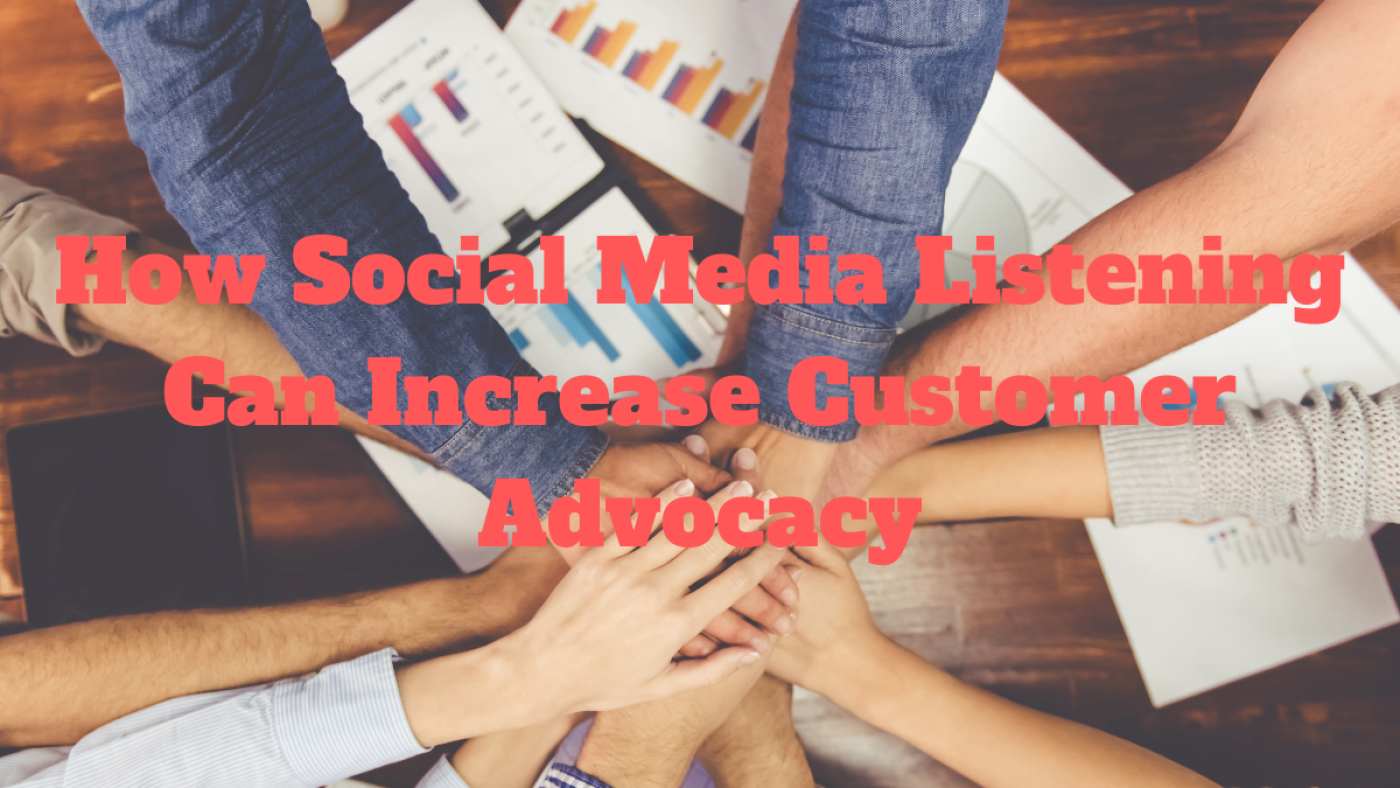If you looking for a How Social Media Listening Can Increase Customer Advocacy. social media networking is becoming more than simply a way to interact with friends listening social media and share pictures in the modern digital era.
Businesses may now use it as a potent tool to interact with their audience and promote brand advocacy social media channels. One of the key strategies for achieving this is through social media listening.
What is Social Media Listening?
How can social media listening increase customer advocacy hubspot.
the practice of social media monitoring, or social media listening, entails tracking and analyzing conversations and mentions about a brand, product, or industry across various social media channels.
It involves monitoring keywords, hashtags and mentions to obtain insightful knowledge about the attitude, tastes, and trends.
Understanding Customer Advocacy
Saying about Customer advocacy refers to customers recommending or voluntarily promoting a brand media channels , product, or listing social media service to others. It’s a valuable asset for any business as it helps build trust social media channels , credibility, and loyalty among potential customers.
The Role of Social Media in Customer Advocacy
Social media listening is crucial in influencing how consumers perceptions and behaviors. With millions of users actively sharing their opinions, experiences media channeles, and recommendations, it has become a goldmine of business insights .
Leveraging social media platforms for brand advocacy listening tool is no longer an option but is necessary in today’s competitive landscape.
Social media listening step-by-step
Social media marketing listening, also known as social media monitoring, involves tracking and analyzing social media channels for mentions of specific keywords, topics, brands, or trends benefits. Here’s a step-by-step guide on how to conduct social media brands listening effectively:
Define your objectives:
Determine what you the want to achieve through social media listening monitoring. Whether it’s understanding customer sentiment, monitoring brand mentions, conversations identifying market trends, or tracking competitor activity, clear objectives will guide your listening efforts.
Choose the right tools:
Select a social mediaindustry monitoring tool that fits your needs and budget. There are various options available, ranging from free tools like online Google Alerts and social media platform analytics to more comprehensive paid tools like Hootsuite, Brand watch, Mention, and Sprout Social important.
Identify relevant keywords and topics:
Develop a list of keywords, hashtags, and phrases relevant to your objectives. These could include your brand name social media , product names social media marketing, industry terms, competitor names, and trending topics related to your business.
Select social media platforms:
Determine which social mediaplatforms are all most relevant keyword to your target audience and industry is social media marketing sprout social. Common platforms include Twitter, Facebook, Instagram, LinkedIn, YouTube, Reddit, and industry-specific forums or blogs.
Set up monitoring alerts: best free social media listening tools.
use your chosen monitoring tool to create alerts for the keywords and social media listeningand monitoring topics you identified. Alerts can be set up to notify you in real-time or at specified intervals whenever your specified keywords are mentioned across social media platforms.
Monitor conversations:
Social media listening and analytics. regularly check your monitoring dashboard or notifications to keep track of social media conversations related to your keywords. listening definition Pay attention to the context, sentiment, and frequency of mentions.
Engage with your audience:
Social media listeningand monitoring for business applications. respond promptly to direct mentions of your brand or inquiries from customers. Engage in conversations, address concerns, and thank customers for positive feedback. This demonstrates your responsiveness and commitment to customer satisfaction.
Analyze data and gather insights:
Use the data collected from your social mediamonitoring efforts to identify patterns, trends, and insights. Look for recurring themes, sentiment trends, popular topics, and emerging issues.
This information can help you make informed decisions and refine your social media strategy.
Track performance over time:
Monitor changes in the volume and sentiment of social media listening companies mentions over time. Track the effectiveness of your social media campaigns, content strategy, and customer service efforts. Adjust your approach based on insights gained from ongoing monitoring.
Iterate and optimize:
Continuously refine your social media listening tools strategy based on the insights you gather.
Experiment with different keywords, platforms, and monitoring techniques to improve the accuracy and effectiveness of your listening efforts.
Best Practices for Effective Social Media Listening
- Clearly define your objectives and target audience.
- Use a combination of tools and techniques to capture a comprehensive view of social media conversations.
- Regularly review and refine your keyword lists and monitoring parameters.
- Actively engage with your audience and respond to both positive and negative feedback.
- Collaborate across departments to leverage social media insights for strategic decision-making.
How Social Media Listening Increases Customer Advocacy
Through attentively monitoring client feedback on social media, companies can:
Real-time feedback and insights
Social media listening gives businesses real-time feedback and insights into customer opinions, preferences, and pain points. By monitoring conversations, companies can identify emerging trends, issues, and opportunities, allowing them to respond promptly and appropriately.
Identifying brand advocates and influencers
Social media listening enables businesses to identify and nurture brand advocates and influencers who can help enhance their message and connect with more people.
By engaging with these advocates, companies can cultivate strong relationships and harness the power of word-of-mouth marketing.
Understanding Social Media Listening
Understanding social media listening involves more than just passively monitoring online conversations. It encompasses the systematic tracking, analyzing, and interpreting of digital chatter across various social media platforms.
This process goes beyond merely observing mentions or engagements; it delves into understanding the underlying gain insights into customer sentiments, trends, and patterns within the data. By employing advanced analytics tools and techniques, organizations can extract valuable insights into consumer preferences, opinions, and behaviors.
These insights are instrumental in shaping marketing strategies, product development, customer service initiatives, and overall brand perception management. Social media listening not only enables businesses to stay attuned to the pulse of their audience but also empowers them to respond effectively to emerging opportunities and challenges in the dynamic landscape of social media.
Benefits of Social Media Listening
- Gain valuable insights into customer preferences and market trends.
- Improve brand reputation and customer satisfaction.
- Identify opportunities for product innovation and marketing campaigns.
- Monitor and mitigate potential crises or negative publicity.
- Stay ahead of competitors by understanding their strategies and customer feedback.
- Â
Building Stronger Customer Relationships
Proactive customer engagement is essential for building stronger relationships and fostering brand loyalty. By responding to customer inquiries, feedback, and concerns in a timely and personalized manner, Companies can establish trust by showcasing their dedication to client pleasure.
Creating Personalized Experiences
Social media listeningprovides businesses with valuable information It can be used to tailor advertising strategies and communications.
By tailoring content and offers based on customer preferences and behaviors, companies can create more meaningful and relevant experiences, driving customer advocacy.
Enhancing Brand Reputation
Managing brand reputation is crucial in today’s digital landscape, where a single negative comment or review can impact consumer perceptions.
Social media listening allows businesses to monitor brand sentiment and proactively address any issues or complaints, helping protect and enhance their reputation.
Driving Word-of-Mouth Marketing
Encouraging user-generated content and testimonials is a powerful way to drive word-of-mouth marketing and build brand advocacy.
By showcasing positive customer experiences and stories on social media, businesses can inspire trust and confidence among potential customers. How is brand building best done using social media?
Measuring Success and ROI (Return on investment)
Tracking key metrics such as engagement, sentiment, and advocacy levels is essential for measuring the success of social media listening efforts.
By analyzing these metrics, businesses can demonstrate the impact of social media listening on customer advocacy and ROI.
Conclusion
To sum up, social media listening is an effective tactic for increasing customer advocacy and driving business growth. Businesses may learn a lot by actively listening to and interacting with clients on social media.
build stronger relationships, and enhance their reputation, ultimately leading to increased customer advocacy and loyalty.
FAQS
How does social media listening differ from social media monitoring?
Social media listening involves tracking mentions of a brand and analyzing the context and sentiment behind those mentions to gain deeper insights into customer perceptions and behaviors.
However, social media monitoring is mainly concerned with tracking and reporting mentions without analyzing the underlying data.
Is social media listening only beneficial for large businesses?
No, social media listening can benefit businesses of all sizes. It offers insightful information about the tastes, patterns, and sentiments, allowing businesses to make data-driven decisions and improve their marketing strategies regardless of size.
What are some common challenges associated with social media listening?
Some common challenges include dealing with vast amounts of data, accurately interpreting customer sentiment, and addressing privacy concerns. However, with the right tools and strategies in place, these challenges can be overcome effectively.
How can businesses effectively measure the ROI of social media listening?
Companies can assess social media’s return on investment. listening by tracking key metrics such as engagement, sentiment, brand mentions, and conversions.
By analyzing these metrics over time and correlating them with business outcomes, businesses can demonstrate the impact of social media listeningon their bottom line.
What are some best practices for incorporating social media listening into a marketing strategy?
Some best practices include defining clear objectives, selecting the proper social me


Add a Comment